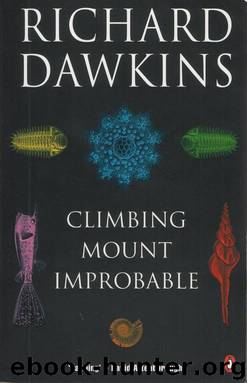Climbing Mount Improbable by Richard Dawkins

Author:Richard Dawkins [Dawkins, Richard]
Language: eng
Format: epub
Tags: Science, Life Sciences, Evolution, Genetics & Genomics
ISBN: 9780393316827
Google: WZucn16SoGoC
Amazon: 0393316823
Publisher: W. W. Norton & Company, Inc.
Published: 1996-10-16T21:00:00+00:00
Figure 5.13 Two kinds of complex lens.
But I was starting to tell the story of how lenses might have evolved in the first place, from a vitreous mass that filled the whole eye. The principle of how it might have happened, and the speed with which it might have been accomplished, has been beautifully demonstrated in a computer model by a pair of Swedish biologists called Dan Nilsson and Susanne Pelger. I shall lead up to explaining their elegant computer model in a slightly oblique way. Instead of going straight to what they actually did, I shall return to our progression from Biomorph to NetSpinner computer models and ask how one could ideally set about making a similar computer model of the evolution of an eye. I shall then explain that this is essentially equivalent to what Nilsson and Pelger did, although they didn’t put it in quite the same way.
Recall that the biomorphs evolved by artificial selection: the selecting agent was human taste. We couldn’t think of a realistic way of incorporating natural selection into the model so we switched to model spider webs instead. The advantage of spider webs was that, since they do their work in a two-dimensional plane, their efficiency in catching flies could be calculated by the computer automatically. So could their cost in silk, and model webs could therefore be automatically ‘chosen’ by the computer in a form of natural selection. We agreed that spider webs were exceptional in this respect: we could not easily hope to do the same for the backbone of a hunting cheetah or the fluke of a swimming whale, because the physical details involved in assessing a three-dimensional organ’s efficiency are too complicated. But an eye is like a spider web in this respect. The efficiency of a model eye drawn in two dimensions can be assessed automatically by the computer. I am not implying that an eye is a two-dimensional structure, because it isn’t. It is just that, if you assume that the eye is circular when seen head on, its efficiency in three dimensions can be assessed from a computer picture of a single vertical slice through the middle. The computer can do a simple ray-tracing analysis and work out the sharpness of image that an eye would be capable of forming. This quality scoring is equivalent to NetSpinner’s calculation of the efficiency of a computer spider web at catching computer flies.
Just as NetSpinner webs procreated mutant daughter webs, so we could let model eyes generate mutant daughter eyes. Each daughter eye would have basically the same shape as the parent, but with a small random change to some minor aspect of its shape. Of course some of these computer ‘eyes’ would be so unlike real eyes as not to deserve the title, but no matter. They could still be bred, and their optical quality could still be given a numerical score—presumably it would be very low. We could therefore, in the same way as NetSpinner, evolve improved eyes by natural selection in the computer.
Download
This site does not store any files on its server. We only index and link to content provided by other sites. Please contact the content providers to delete copyright contents if any and email us, we'll remove relevant links or contents immediately.
Sapiens: A Brief History of Humankind by Yuval Noah Harari(14321)
Sapiens by Yuval Noah Harari(5325)
Pale Blue Dot by Carl Sagan(4957)
Homo Deus: A Brief History of Tomorrow by Yuval Noah Harari(4873)
Livewired by David Eagleman(3730)
Origin Story: A Big History of Everything by David Christian(3666)
Brief Answers to the Big Questions by Stephen Hawking(3393)
Inferior by Angela Saini(3294)
Origin Story by David Christian(3170)
Signature in the Cell: DNA and the Evidence for Intelligent Design by Stephen C. Meyer(3099)
The Gene: An Intimate History by Siddhartha Mukherjee(3075)
The Evolution of Beauty by Richard O. Prum(2965)
Aliens by Jim Al-Khalili(2803)
How The Mind Works by Steven Pinker(2778)
A Short History of Nearly Everything by Bryson Bill(2662)
Sex at Dawn: The Prehistoric Origins of Modern Sexuality by Ryan Christopher(2500)
From Bacteria to Bach and Back by Daniel C. Dennett(2462)
Endless Forms Most Beautiful by Sean B. Carroll(2444)
Who We Are and How We Got Here by David Reich(2418)
